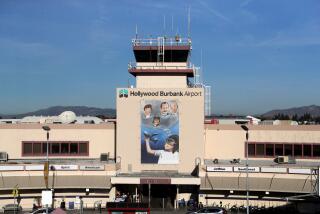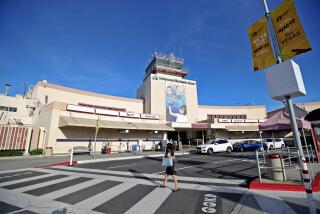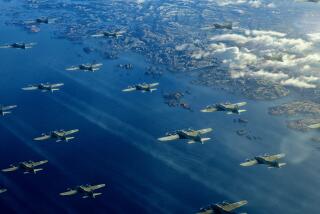Lockheed, Burbank Aviation Dream Is Temporarily Grounded
- Share via
Quite unknown to the thousands of airline passengers making their arrivals and departures, Monday was a sad day in the annals of Burbank Airport.
It was the day a gleaming Lockheed Constellation didn’t fly out of an azure sky and glide to a dramatic stop on the Tarmac.
The landing of the Connie, one of the few working specimens of the beloved Lockheed transport with the distinctive dolphin fuselage and triple stabilizer tail, was to have kicked off a week of aviation nostalgia ending at 7:30 tonight in a gathering of former Lockheed pilots, engineers and assembly line workers at the Burbank Airport Terminal.
All these festivities had a larger purpose: to start the bandwagon rolling for their plan to create a permanent exhibit of great Lockheed planes ranging from the pre-World War II Sirius flown by Charles Lindbergh to the Stealth fighter that evaded enemy radar in the Gulf War.
Having few resources of their own beyond enthusiasm, the dozen or so board members of the Burbank Aviation Museum hope to persuade the city of Burbank and Lockheed to pitch in the basic requirements.
All they need is “cash or land, or cash or land,” said member Ron Dickson, a second-generation East Valley resident who can work himself into tears talking about the “64 years of aviation history in the east San Fernando Valley,” that is slipping away with the demise of the Cold War.
Dickson envisions the great ones displayed somewhere amid Lockheed’s abandoned facilities: the P-38 Lightning, the F-104 Starfighter, the U-2, the SR-71.
So far, he hasn’t even had a nibble.
Dickson hoped the arrival of the Constellation might stir up old emotions. The Constellation, known affectionately as the Connie to a generation of pilots and flight engineers, opened the era of nonstop transcontinental and intercontinental air travel in post-World War II America.
To grasp the East Valley’s place in this story, look back 50 years to the day an impetuous Howard Hughes, principal stockholder of Transcontinental & Western Air, Inc., showed up at Burbank Airport to learn how to fly the plane.
Hughes intended to pilot a Connie on a record-breaking cross-country flight for the press and Hollywood celebrities. Lockheed’s top brass joined the eccentric transportation mogul in his first check-out flight.
The fun began when the Connie climbed to 2,000 feet above the hills, according to Clarence L. (Kelly) Johnson, creator of Lockheed’s famous “Skunk Works” and a passenger on Hughes’ unforgettable training flight.
As Johnson recalled in his autobiography, Hughes thought Lockheed flight engineer Milo Burcham was too timid in his handling of a stall maneuver.
“Milo turned the controls over to him,” Johnson wrote. “Hughes then proceeded to pull back the control column all the way into his lap, as far as it would go, to stall the airplane.
“Never before nor since have I seen an airspeed indicator read zero in the air. But that’s the speed we reached--zero--with a big, four-engine airplane pointed 90 degrees to the horizon . . . “
Miraculously, the craft righted itself, Johnson ordered Hughes to surrender the controls, and the aviator’s chagrin almost cost Lockheed the deal.
Tempers cooled, Hughes put the Constellation into service, and it became one of the most admired aircraft of all time, flown by other lines such as Pan Am, Lufthansa, BOAC and Quantas. In all 856 of them rolled off the Burbank assembly line--but it’s a fair bet that none has landed there since the 1960s when jetliners made the prop-engine Connies obsolete.
Today, only a few dozen survive. At most nine still fly, experts estimate. One used by Dwight Eisenhower, “Columbine,” now rests at the Pima Air Museum in Arizona and the “Bataan” of Gen. Douglas MacArthur is on display at the Chino Air Museum.
Treasures such as these are reserved for people who have pocketbooks equal to their boundless love of aviation history, so it isn’t likely, at least in their present impecunious state, that the 250 or so backers of the Burbank Air Museum will ever bring one home for good.
At this point, they’d settle for just seeing one come home for a visit. And this week, one almost did.
The plane would have flown from Scottsdale, Ariz., where former Microsoft computer consultant Vern Raburn has based The Constellation Group, a small establishment that keeps one Connie flying.
Raburn’s Connie is a military model delivered to the U.S. Air Force in 1948 that flew in the Berlin airlift. The Burbank flight was scheduled months ago, but trouble arose last August on a routine maintenance run. A hydraulic line ruptured, leaving the Connie without brakes on a downhill runway. It plunked to a stop in a ditch, damaging seven of its rare Curtiss-Wright hollow aluminum propellers.
*
A worldwide search led to Santo Domingo where a junked Connie had the right engines and props--for a price. “You have no idea,” how hard it is to keep a 50-year-old plane flying, said the Constellation Group’s assistant office manager Sheryl Hutcherson. “It is hideously expensive.”
By the time the props were available, their control motors, which had been sent to Tuscon for repair, “fell off the truck,” and were damaged, Hutcherson said.
Oh, that Connie is still going to make it back to Burbank. Just no telling when.
Even without it, Dickson is plunging ahead with tonight’s meeting.
After that, he’s not sure how much more he has to give to dreams.
“This is going to be my last shot,” he said.
More to Read
Inside the business of entertainment
The Wide Shot brings you news, analysis and insights on everything from streaming wars to production — and what it all means for the future.
You may occasionally receive promotional content from the Los Angeles Times.











